Land Art – A Look at Earth Artists and Their Famous Land Art Works
What is Land art or Earthwork art, and what is the earthworks definition in art? Earth art, often known as land art, is creative work produced directly in the environment by shaping the ground. Earth artists construct objects in the landscape from organic materials like pebbles or twigs. If you would like to learn more about earth art and explore famous land art examples, then look no further!
The Natural Beauty of Land Art
Earthwork art was typically documented utilizing photos and maps that the earth artists were able to display in an exhibition. Earth artists created earth art in exhibitions as well, hauling in materials from the environment and incorporating them into their artworks. The Earth art movement evolved from various influences such as Conceptual and Minimal art, and the early stages of environmentalism.
The widespread commercialization of American artwork in the late 1960s impacted concepts and pieces that were, to varying degrees, alienated from the established art market.
History of the Land Art Movement
Earth artists preferred elements that could be taken straight from the natural environment, such as water, gravel, pebbles, and dirt. Earthwork artists were motivated by prehistoric works such as Stonehenge and left their creations exposed to the weather.
Because of the sculptures’ ephemeral nature and ultimate decomposition, they were pushed outside of the art establishment, where art objects were normally put on a pedestal and kept in restricted conditions.
Earth Art’s Continuation of Conceptual and Minimalist Ideas
The period of the late 1960s and early 1970s was one of the most exploratory eras in Western art history, with multiple parallel trends and artists producing in more than one manner, which made it difficult to clearly assign aesthetic tags to artworks from the period.
Land art, for instance, shared certain traits with Minimalism, such as a preoccupation with how items filled their spaces, human engagement with artworks, and most importantly, form simplicity.
Even though the implementation of a Minimalist visual style was frequently crucial to Earthwork art, the earth artists were traditionally hands-on with the documenting and method of production, on certain occasions including a performance art component; these attributes associated Earthwork artists more with post-Minimalist inclinations such as performance and installation art.
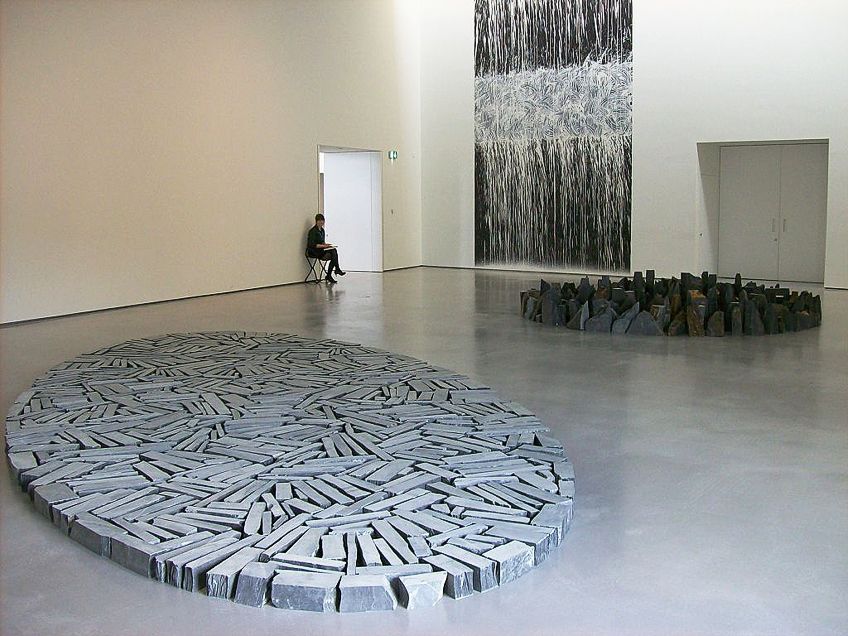
Earthworks, which were mostly created outside and were built of natural materials, were also vulnerable to deterioration and degradation through time, which was in contrast to Minimalism’s more industrialized and urban look, rendering it one of the most distinctive aspects of the Earth art movement.
Land art, like Conceptual art, was about more than only the artwork’s aesthetic and visual enjoyment.
Almost all Earthworks emphasized refusal of economic status and conventional exhibition spaces, instead emphasizing an ephemeral nature. Therefore, while the bulk of Earth art was physically spectacular, the works were infused with these ideals of impermanence at their foundation.
Land Art in the 1960s
Earth artists were generally the product of the Vietnam period, with many having been enlisted to participate in the war and attending college on the G.I. Bill. Many, such as Michael Heizer and Robert Smithson, started as painters. Smithson’s early works progressed from pictorial abstractions to geometric paintings and, finally, sculpture.
Smithson started exhibiting with the prominent gallerist Virginia Dwan in 1966, who would have a huge impact on the Earth art movement.
Simultaneously, Smithson started to work as an advisor for a New York City engineering business, which prompted him to develop “Aerial Art” for the Fort Worth airport in Dallas. Aerial Art consisted of massive artworks to be built between the runways and observed from above during the airplane’s takeoffs and landings.

Aerial art never became a viable art genre, yet Smithson and his peers, including Nancy Holt, Robert Morris, Carl Andre, and Michael Heizer, were motivated by the concept of exploring numerous unexplored territories in adjacent New Jersey and western states that offered wide, open landscapes. Dwan, the heiress to the famous 3M company who had chosen to pursue art, frequently escorted artists to remote locations and offered considerable encouragement and assistance to Earth art initiatives that would have failed without money.
Dwan staged a display titled Earth Works at her New York City gallery space in 1968, officially recognizing a group of groundbreaking Earth artists.
The exhibition documented their Earth work’s inception through maps, pictures, slides, and sketches. While these artists attempted to avoid established establishments, they were sometimes compelled to accept support from them to further their initiatives. Furthermore, the movement was frequently accused of elitism due to the remoteness of many spots, several of which one could only observe from private planes.
Later Developments
The recession of the mid-1970s had a significant influence on Earth art financing. Many artists relied on sponsors to acquire enormous tracts of land to execute big-scale works. In addition to the socioeconomic downturn, Robert Smithson’s untimely death in 1973 while scouting potential sites in Texas disrupted the movement’s pace.
Those who made their reputations through Earth art, like Heizer, De Maria, Morris, and Andre, shifted their focus, reorienting their work to fit institutions and galleries.
Land art ushered in a new era of art that prioritized installations above single pieces, subverting creative production assumptions. During this era, the principles of Conceptualism grew prevalent in the world of art, as numerous groups started to exchange concepts and support artists who worked in various institutional settings.
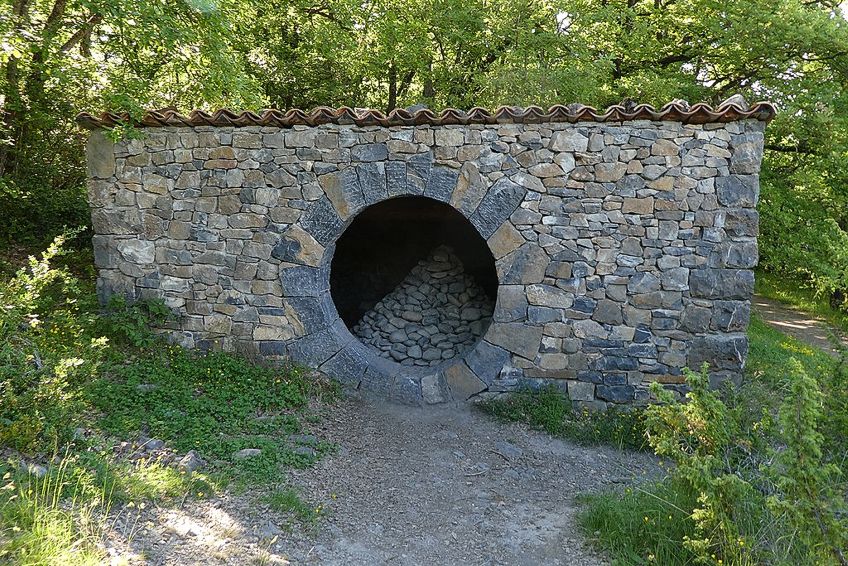
Post-Minimalist trends like Process art were inextricably linked to Land art, and several artists producing between the movements shifted to the gallery model when the economy deteriorated and affordable alternative places became accessible in metropolitan areas. Conceptual art also heralded a new age of performance, which transferred effectively in gallery spaces and, like Earthwork art, undermined traditional views of art as a product due to its transience.
Organic materials were used in the exhibition space on occasion, and emphasis on the transitory was communicated through site-specific and ephemeral works.
Earthwork Art Styles and Concepts
Smithson defined “Site” and “Nonsite” to denote conceptual contrasts in the physical environment of works produced. “Nonsite” was defined as “interior earthwork” and denoted a work that could be displayed in a gallery environment, removing organic elements from their natural locations and accompanied by drawings or pictures. The term “site” alluded to works made outside of the exhibition framework in site-specific locations using materials sourced from that area.
Smithson’s elaboration of these frameworks, combined with the late 1960s activist attitude, reinforced the desire of certain Earth artists to address humans’ connection with the planet.
Art Entropy
Earthwork artists were inspired by huge ancient and prehistoric structures such as Stonehenge and Native American burial sites. Heizer initially saw these prehistoric locations as a youngster, accompanying his father, an archaeologist, to numerous digs.
The prehistoric monuments reflected the advancement of time through gradual deterioration and erosion due to their continuing presence.

Earthworks relied on the entropy of the substances, both artificial and biological. Outdoor works by Smithson and Heizer were naturally susceptible to the destruction of the weather, thus deterioration and fragmentation were inherent to their significance; preservation was viewed as a folly.
Non-Invasive and Invasive Earth Art
Earthworks are frequently categorized into those that significantly alter the terrain and those that don’t. Projects in the former category typically necessitate the use of earth-moving machinery to make significant changes to a site.
Non-invasive projects are regarded as more considerate of the environment.
Examples of Famous Land Art
When constructing art, earthwork artists frequently used the materials that were accessible at the spot where their creations were built and then presented, which recognized the uniqueness of the location. Locations were frequently chosen for specific purposes.
For instance, Robert Smithson used ruined locations for his artworks in order to represent regeneration and renewal.
This concept of site-specificity was presented to the world of art by Land art, once again putting the artists at the forefront because their works frequently necessitated wide, open areas, which meant that many of their projects were not accessible to the ordinary audience, calling into question the very function of artwork as a thing to be observed.
A Line Made by Walking (1967) by Richard Long
| Artist | Richard Long (1945 – Present) |
| Medium | Photo Document of Performance |
| Dimensions (cm) | Unspecified |
| Original Location | Wiltshire, London |
This example of Land art was produced by Richard Long during his time as a scholar in London. It recounts a piece he developed while walking to and fro over the same pathway in Wiltshire. Long stresses the experience aspect of nature through the activity of walking, as well as the temporal aspect of creative processes, while also influencing the land.
The interplay of the voyage, denoting the ground, and producing a modest alteration to the scenery is the subject matter.
The piece is also evocative of subsequent Minimalist works due to its basic, geometric design and minimum interference with the location. The project, like other Earthworks, is site-specific and impermanent. The photographs record the artwork’s transitory existence, but they do not entirely encompass it.
While the images only capture the execution of the work, the documentation was occasionally significant to Earth art artists since it was frequently the only method to prove the piece’s production.
Richard Long’s artwork was revolutionary in its complete minimalism and ephemerality since it would have vanished within days or weeks as nature took its course. This essentially rendered the artwork meaningless as a commodities product.
Annual Rings (1968) by Dennis Oppenheim
| Artist | Dennis Oppenheim (1938 – 2011) |
| Medium | Gelatin print documentation of work |
| Dimensions (cm) | 101 x 76 |
| Original Location | Unspecified |
Dennis Oppenheim’s Annual Rings, for which he created enormous concentric patterns into a frozen coating over a river, is inspired by ideas of time that can be found in the circles of cut trees and snow patterns. The artist “enlarged the patterning of the tree’s development and, by digging paths in the snow, translated the yearly rings to the frozen lake that divides Canada and the US and also splits their various time zones,” according to a summary of the piece from the Metropolitan Museum of Art.
Oppenheim, according to the Met, “opened to query the comparative values of the systems by which we function” by experimenting with the concept of borders between both time and space.
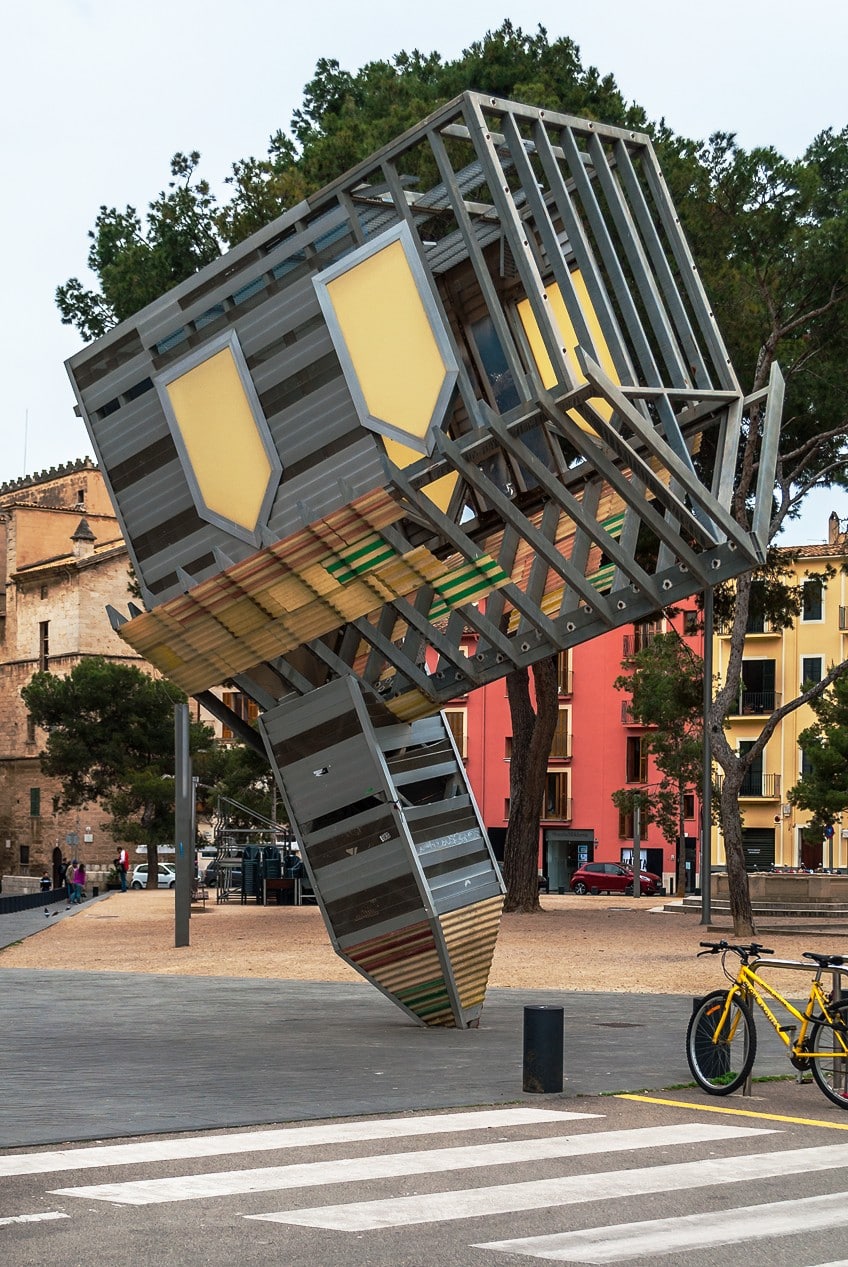
Alternatively, as Dennis Oppenheim stated in an interview at the time, “let us presume that artwork has drifted away from its mechanical phase and that it is now more preoccupied with the position of materials and interpretation.”
Double Negative (1970) by Michael Heizer
| Artist | Michael Heizer (1944 – Present) |
| Medium | Trenches |
| Dimensions (cm) | 4,570 |
| Original Location | Mormon Mesa, Nevada |
Michael Heizer started this mammoth job in 1969, with financial aid from Virginia Dwan, cutting thousands of tons of sandstone off bluffs to build two ditches on the eastern margins of the Mormon Mesa, Nevada. Because few people could visit the location once the work was completed, Heizer photographed the process and displayed it at the Dwan Gallery in New York.
Heizer makes a courageous move with Double Negative by removing soil from its location, requiring a consideration of the mechanical processes that comprise the work and the organic, physical components that exist outside of it.
He situates Double Negative in the framework of art history and architecture, referencing megalithic ancient structures as well as current technical accomplishments of the industrial period. Although the construction took a significant amount of labor, it is essentially a 457-meter-long valley into which a visitor would walk to be enclosed on three sides by 50-foot earthen walls.

The work’s site-specificity and isolation are hallmarks of Earth art, as it would only be accessible to a small number of spectators. Because it is in the open air of the desert, it is vulnerable to the elements and may ultimately disappear. The work is linked to Minimalism because of its simple design, the emphasis on the audience’s kinesthetic reaction to its significance, and its massive scale.
This was supposed to overpower the spectator, making them feel tiny among the enormity of the environment and the piece of art.
Spiral Jetty (1970) by Robert Smithson
| Artist | Robert Smithson (1938 – 1973) |
| Medium | Limestone, basalt rock, algae |
| Dimensions (cm) | 4,570 |
| Original Location | Utah, USA |
Spiral Jetty, the most famous of the large earthwork pieces of the 1970s, is a 450-meter vortex built with over 6,000 tons of basalt rocks that spin out into the Great Salt Lake in Utah. Robert Smithson had been fascinated by the lake since hearing that there were particular organism-infested areas in the water that was “the hue of tomato soup,” as he put it, and one of his many obsessions in the artwork itself was toying with the perception of scale.
He remarked, “Length measures a thing, but scale defines art.
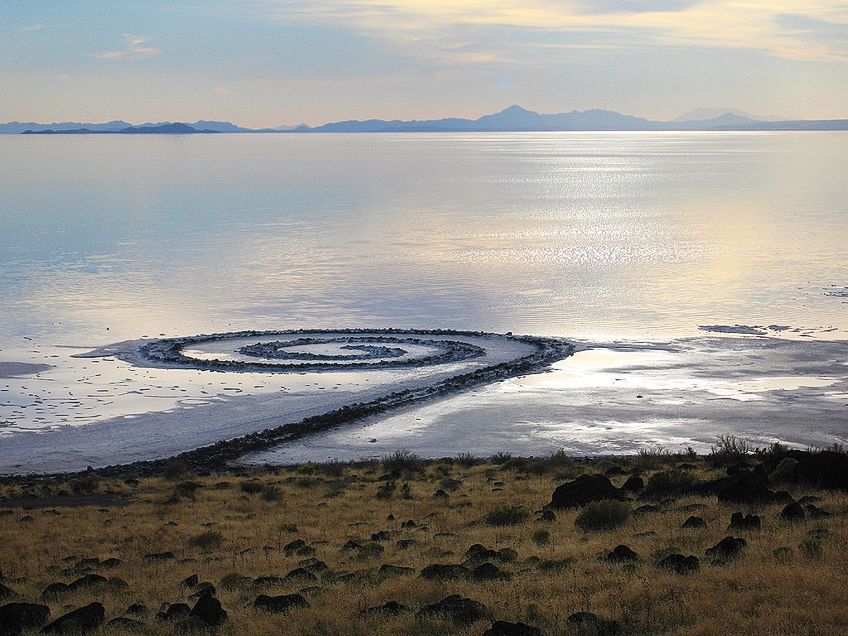
If regarded in terms of scale rather than size, a fracture in the wall may be labeled the Grand Canyon. Space might be created to accommodate the vastness of the solar system.” Smithson’s oeuvre in its entirety was representative of Earth art in its rebellion against the commercialization of the art market because the work could not be bought or sold. The artwork’s physical transformation, and even obscurity, as a result of natural events such as flowing water and erosion, were critical to its significance.
Spiral Jetty is one of the greatest instances of Land art and also emphasizes the movement’s foundations in Conceptualism.
Star Axis (1971) by Charles Ross
| Artist | Charles Ross (1971 – Present) |
| Medium | Sandstone, granite |
| Dimensions (cm) | Unspecified |
| Original Location | New Mexico Desert |
Star Axis is situated in the New Mexico desert. It functions as both an architectural artwork and an observatory. Star Axis was created by collecting several star alignments at various time scales and sculpting them into physical shapes.
Walking inside its halls, you can observe how stellar space compares to human scale and how stellar space extends into the earth.
Ross dreamed up Star Axis in 1971 and started construction in 1976, following a four-year quest in the southwest for the ideal location—a plateau where one stands at the threshold between earth and sky. He’s now working on Star Axis with a group of native stonemasons.
Ross has experimented with light in many ways and has been building this 11-story-tall masterwork for several decades.
Sun Tunnels (1976) by Nancy Holt
| Artist | Nancy Holt |
| Medium | Concrete Cylinders |
| Dimensions (cm) | 500 |
| Original Location | Utah, USA |
Nancy Holt erected four massive concrete hollowed cylinders, each of them 5 meters in diameter, at specific geographical places to synchronize with the sunset and sunrise during the winter and summer solstices, much like Stonehenge. Holt, who was fascinated by astronomy, perforated the cylinders with gaps of varying sizes to generate shadows of several constellations.
Holt, like many other Earth painters, had a strong passion for the sciences and ecology that was influenced by her undergraduate studies at Tufts University.
Sun Tunnels analyzes the physical aspects of perception by accurately positioning the sun on the skyline and enabling light to pass through the holes based on the placement of available light. Holt made preliminary light works on paper, capturing the interplay of sunlight in two- and three-dimensional representations. Holt’s research-based approach and focus on remote locations linked her not just to other artists who work in this method, but also to Conceptual concerns with the merging of artwork and concepts.
The work is not intended to disappear like other Earthworks, but rather to call attention to the subtleties of the natural world in a site-specific and isolated location.
The Lightning Field (1977) by Walter de Maria
| Artist | Walter de Maria |
| Medium | Stainless steel poles |
| Dimensions (cm) | 100,000 x 100,000 |
| Original Location | New Mexico |
The Lightning Field, a grid of 400 silver poles arranged in a row on a wide stretch of desert encircled by mountain ranges in New Mexico, is one of the most fantastical Land art pieces ever created. The encounter is very sensory, with an overnighter necessary in a cabin that accommodates six people who book in advance.
And it all changes with the time that passes amid the calm but dynamic environment, with variances in lighting making the poles look undetectable when not blazing with bright orange and yellow flares from lightning strikes hitting the poles.
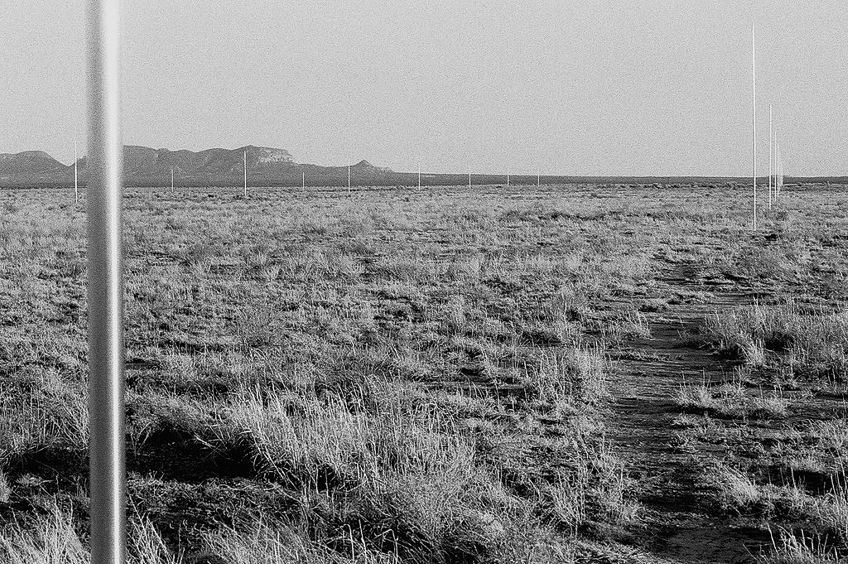
Whether lightning actually hits may become secondary to a moment that is no less amazing without it, and returning to the outside world at the conclusion of a visit can transform a person. “Isolation is the core of Land Art,” said Walter De Maria.
But so is a sense of community with all things and all companion energies in an atmosphere that even the most observant of us may spend our lives enjoying all over again.
Wheatfield (1982) by Agnes Denes
| Artist | Agnes Denes (1931 – present) |
| Medium | Wheat |
| Dimensions (cm) | Two acres |
| Original Location | Battery Park Landfill |
Denes’ most famous achievement was a wheat field seeded and cultivated in Battery Park landfill, only steps from the World Trade Center. Denes and her assistants dug the congested earth and planted the seeds by themselves on this site, which was valued at 4.5 billion dollars, with the support of a $10,000 subsidy from the Public Art Fund.
They then tended to the crops for four months until reaping over 1000 pounds of wheat on the 16th of August 1982. The wheat was later displayed in The Worldwide Art Show to End World Hunger, which toured 28 international locations.
Visitors to the show purchased wheat grains and sowed them all over the world. Wheatfield is now home to premium offices and apartment buildings. The “confrontation” in the name of this artwork is not between the contrasts and commonalities of nature and humans, as is typical of Denes’ artwork, but instead squarely between their opposing features, to call attention to the devastation being produced. This essay was far more activist in tone than some of her previous work.
Denes was initially commissioned to construct a sculpture in a more tranquil region of Queens but insisted on the Battery Park Landfill. The wheat field, evoking the lost fertility of the earth underneath New York and the prospective sustenance it might generate, was a clear and striking metaphor for this alternate site.
Wheatfield stood in sharp contrast to the indulgences of the financial industry it surrounded in a worldwide context that was witnessing pockets of acute world hunger and fast dwindling natural resources.
Pebbles, Broken and Scraped White with Another Stone (1985) by Andy Goldsworthy
| Artist | Andy Goldsworthy (1956 – present) |
| Medium | Photo of work |
| Dimensions (cm) | Unspecified |
| Original Location | Unspecified |
One of the most famous Earth artists is Andy Goldsworthy, who strives to build a temporal link in his works. Goldsworthy works with natural elements such as stones, branches, plants, water, and snow to produce transient images in a natural context.
The ostensibly “finished” work is documented, but the production and eventual collapse of the piece also define its status.
The title of this work meticulously defines the procedure by which the artwork was made, the elements used, and the physical attributes of the piece. Although Goldsworthy has recorded the work, the piece will deteriorate and lose its significance as art over time.
These examples of famous Land art have shown how artwork can be made and co-exist with the natural world. Without any necessary raw materials except what is provided, the Earth artists were able to create sometimes temporary structures that served to exhibit a specific idea or notion to the public. However, due to the isolated locations of most Earth artwork, most people will never fully experience what the artist had in mind beyond photo documentation.
Frequently Asked Questions
What Is Land Art Exactly?
When the creators who established what is now known as Land art ventured beyond gallery walls and museums to the wide outdoors, they encountered a realm devoid of constraints and abundant in earthy resources to work with. Rather than white walls sprouting up around them, there were enormous stretches of space and ever-expanding horizons, and instead of materials like resin and paint, they used pebbles and dirt. Land artists engaged with the terrain with a variety of thought-provoking installations and artworks to raise awareness of man’s interaction with the natural environment.
What Is the Earthworks Definition in Art?
Land art is a method or type of art creation that uses natural materials or places the artwork outside in different settings to engage with the environment in some manner. The concept of land art, often known as earthwork art, originated in the 1960s and became increasingly popular and gained momentum during the next decade. Land art combined materials gathered from the environment with the energy and creativity of the artist in a variety of styles ranging from altered streams to small-scaled intrusions such as lines of footprints in the earth. Mankind frequently considers nature as a background for the relevance of our personal and social life and evolution. Earth art, on the other hand, puts nature front and center, informing us all that the complexity and nuanced methods of interaction in the natural environment are much better than anything humans have accomplished or might produce.
Jordan Anthony is a Cape Town-based film photographer, curator, and arts writer. She holds a Bachelor of Art in Fine Arts from the University of the Witwatersrand, Johannesburg, where she explored themes like healing, identity, dreams, and intuitive creation in her Contemporary art practice. Jordan has collaborated with various local art institutions, including the KZNSA Gallery in Durban, the Turbine Art Fair, and the Wits Art Museum. Her photography focuses on abstract color manipulations, portraiture, candid shots, and urban landscapes. She’s intrigued by philosophy, memory, and esotericism, drawing inspiration from Surrealism, Fluxus, and ancient civilizations, as well as childhood influences and found objects. Jordan is working for artfilemagazine since 2022 and writes blog posts about art history and photography.
Learn more about Jordan Anthony and about us.
Cite this Article
Jordan, Anthony, “Land Art – A Look at Earth Artists and Their Famous Land Art Works.” artfilemagazine – Your Online Art Source. August 13, 2022. URL: https://artfilemagazine.com/land-art/
Anthony, J. (2022, 13 August). Land Art – A Look at Earth Artists and Their Famous Land Art Works. artfilemagazine – Your Online Art Source. https://artfilemagazine.com/land-art/
Anthony, Jordan. “Land Art – A Look at Earth Artists and Their Famous Land Art Works.” artfilemagazine – Your Online Art Source, August 13, 2022. https://artfilemagazine.com/land-art/.



